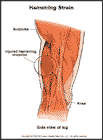
Hamstring Strain
What is a hamstring strain?
A strain is a stretch or tear of a muscle or tendon. People commonly call such an injury a "pulled" muscle.
Your hamstring muscle group is in the back of your thigh and allows you to bend your knee. It is made up of three large muscles: the biceps, semimembranosus, and semitendinosus.
How does it occur?
A hamstring muscle strain usually occurs when these muscles are contracted forcefully during activities such as running or jumping.
What are the symptoms?
There is often a burning feeling or a popping when the injury occurs. You have pain when walking or when bending or straightening your leg. A few days after the injury, you may have bruising on your leg just below the injury.
How is it diagnosed?
Your health care provider will examine your leg and find tenderness at the site of the injury.
How is it treated?
Treatment may include:
- applying ice packs to your hamstrings for 20 to 30 minutes every 3 to 4 hours for 2 to 3 days or until the pain goes away
- elevating your leg by placing a pillow underneath it
- wrapping an elastic bandage around your leg for compression to keep the swelling from getting worse
- taking anti-inflammatory medication according to your health care provider's prescription
- using crutches if it is too painful to walk.
As you return to your activity, you may be given an elastic thigh wrap to give extra support to your hamstrings. While you are recovering from your injury, you will need to change your sport or activity to one that does not make your condition worse. For example, you may need to swim or bicycle instead of run.
When can I return to my sport or activity?
The goal of rehabilitation is to return you to your sport or activity as soon as is safely possible. If you return too soon you may worsen your injury, which could lead to permanent damage. Everyone recovers from injury at a different rate. Return to your sport or activity will be determined by how soon your leg recovers, not by how many days or weeks it has been since your injury occurred. In general, the longer you have symptoms before you start treatment, the longer it will take to get better.
You may safely return to your sport or activity when, starting from the top of the list and progressing to the end, each of the following is true:
- You have full range of motion in the injured leg compared to the uninjured leg.
- You have full strength of the injured leg compared to the uninjured leg.
- You can jog straight ahead without pain or limping.
- You can sprint straight ahead without pain or limping.
- You can do 45-degree cuts, first at half-speed, then at full-speed.
- You can do 20-yard figures-of-eight, first at half-speed, then at full-speed.
- You can do 90-degree cuts, first at half-speed, then at full-speed.
- You can do 10-yard figures-of-eight, first at half-speed, then at full-speed.
- You can jump on both legs without pain and you can jump on the injured leg without pain.
How can I prevent a hamstring strain?
A hamstring strain is best prevented by warming up properly and stretching your hamstring muscles prior to your activities. This is especially important in sprinting or jumping.

